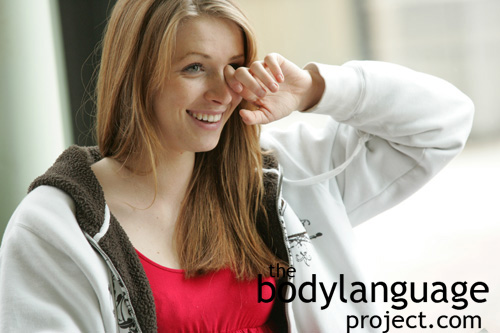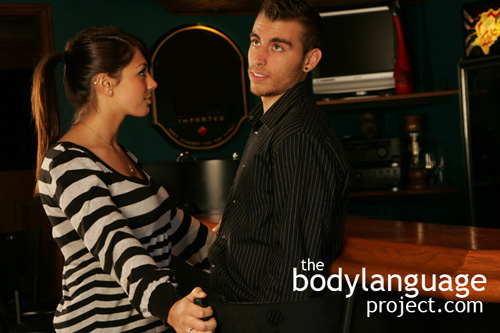Body Language of Hand To Eye Gesture or Eye Rubbing Gesture

 Cue: Hand To Eye Gesture
Cue: Hand To Eye Gesture
Synonym(s): Eye Rubbing, Touching The Eye, Rubbing The Eye, Eye Touching.
Description: Occurs as the hand comes up and rubs the eye with the eyelid closed or rubs the skin around the eye particularly just on the out or inside edge – the corner of the eye or the edge of the nose. Touching the eye may be stifled by coming up short and simply touching the upper cheek. At times, the gesture is done quite delicately as a mild stroke almost as if a person is simply pointing at the edge of their eye.
In One Sentence: Hand to eye gestures signal that a person can’t believe what they are seeing.
How To Use it: As the cue mostly goes unnoticed by others, it’s application is limited. However, rubbing the eyes in an exaggerated way, signals disbelief and can help reinforce your position.
Context: General.
Verbal Translation: a) “I’m rubbing my eyes in disbelief because I can’t believe what I’m seeing.” b) “I’m touching my eye briefly because I don’t like what I just heard, saw or learned.” c) “I’m lying and I’m embarrassed by my own action so I’m going to cover up my eyes like I did when I was a kid – though stop short and instead just scratch my upper cheek instead.”
Variant: Instead of eye rubbing, the upper cheek may be scratched, the eyelid might be rubbed or the corner of the eye may be manipulated or itched. Sometimes the knuckle of the index finger is rubbed and twisted in the corner of the eye to relieve discomfort. See eye blocking category.
Cue In Action: a) The kid’s mom couldn’t believe what her 2-year-old had done with the flour. It was head-to-toe and top to bottom, and all over the kitchen in mere minutes. She rubbed her eyes vigorously, as if she could erase from view the miserable sight. b) The guy was obviously lying. Following his statement “I did not have sexual relations with that woman” he scratched just below his eye. The pain of his tall tale caused him to seek relief from the discomfort.
Meaning and/or Motivation: When it is not done to alleviate an itch it is a widespread gesture indicating a negative thought, doubt, or disbelieve at what is being said or seen depending on the context.
If the eyes are touched briefly it can signal that someone has said something that has caused discomfort. When eyes actually need scratching, they will happen at random rather than coupled with critical information.
People can be caught punctuating their own lies by momentarily touching their eye as if they are trying to prevent the discomfort associate with bearing witness to them. When lying is due to negative thoughts it is an abbreviated form of eye blocking. Think back to childhood when you would have covered your eyes if you saw something frightening on television. As we grow older, our cues become more constrained so instead of cupping our hands over both eyes, we just touch the corner of the eye or come up short and scratch the upper cheek instead.
When rubbing the eye has no meaning, it is done to alleviate and itch or to sooth sore eyes that are tired. When men bring their hand to their eyes they might vigorously rub, whereas women will lightly rub around the eye so as not to smear their make-up.
Cue Cluster: When eye rubbing indicates a negative thought, watch for additional nervousness such as palm scratching due to sweating, scratching the neck or pulling the collar away, voice trembling and eye contact that suddenly ceases.
Body Language Category: Adaptors, Amplifier, Auto contact or self touching, Eye blocking, Eye Language, Nervous body language, Stressful body language.
Resources:
Akehurst, L., G. Kohnken, A. Vrij, and R. Bull. 1996. Lay persons’ and police officers’
beliefs regarding deceptive behaviour. Applied Cognitive Psychology 10: 461-471.
Appelbaum, P.S. The new lie detectors: Neuroscience, deception, and the courts. Psychiatric Services. 2007. 58: 460-462.
Burgoon, Judee ; Proudfoot, Jeffrey ; Schuetzler, Ryan ; Wilson, David. Patterns of Nonverbal Behavior Associated with Truth and Deception: Illustrations from Three Experiments. Journal of Nonverbal Behavior. 2014: 38(3) 325-354.
Barroso, Felix ; Feld, Jason. Self-touching and attentional processes: The role of task difficulty, selection stage, and sex differences. Journal of Nonverbal Behavior. 1986. 10(1): 51-64.
Butzen, Nathan David ; Bissonnette, Victor ; Mcbrayer, Dan. Effects of modeling and topic stimulus on self-referent touching. Perceptual and motor skills. 2005. 101(2): 413-20.
Broome, Marion E.. Helping Parents Support Their Child In Pain. Pediatric Nursing. 2000. 26(3): 315.
Bornstein, Marc H. ; Tamis-Lemonda, Catherine S. Maternal responsiveness and infant mental abilities: Specific predictive relations. Infant Behavior and Development. 1997. 20(3): 283-296.
Buckley, V., & Semple, S. (2012). Evidence that displacement activities facilitate behavioural transitions in ring-tailed lemurs. Behavioural Processes, 90, 433–435.
Bernal, Gilda Rios ; Wortham, Suec. How to Calm Children through Massage. Childhood Education. 1997. 74(1): 9-14.
Bouhuys, A.L. ; Jansen, C.J. ; van den Hoofdakker, R.H. Analysis of observed behaviors displayed by depressed patients during a clinical interview: relationships between behavioral factors and clinical concepts of activation. Journal of Affective Disorders. 1991. 21(2): 79-88.
Bouhuys, A.L. ; Beersma, Domien G.M. ; van den Hoofdakker, Rutger H. Observed behavior as a predictor of the response to sleep deprivation in depressed patients. Psychiatry Research. 1989. 28(1): 47-61.
Berridge CW,Mitton E, ClarkW, Roth RH. 1999. Engagement in a non-escape (displacement) behavior elicits a selective and lateralized suppression of frontal cortical dopaminergic utilization in stress. Synapse 32:187–197.
Burgoon, Judee ; Proudfoot, Jeffrey ; Schuetzler, Ryan ; Wilson, David. Patterns of Nonverbal Behavior Associated with Truth and Deception: Illustrations from Three Experiments. Journal of Nonverbal Behavior. 2014: 38(3) 325-354.
Bond, Michael H., and Hiroshi Komai (1976). “Targets of Gazing and Eye Contact During Interviews: Effects on Japanese Nonverbal Behavior.” In Journal of Personality and Social Psychology (Vol. 34), pp. 1276-84.
Blakeslee, Sandra (1995). “In Brain’s Early Growth, Timetable Maybe Crucial.” In New York Times (“Science Times,” August 29), pp. C1, C3.
Costa, Marco ; Dinsbach, Wies ; Manstead, Antony ; Bitti, Pio. Social Presence, Embarrassment, and Nonverbal Behavior. Journal of Nonverbal Behavior. 2001. 25(4): 225-240.
Crossman, Angela M. ; Lewis, Michael Felthous, Alan R. Adults’ ability to detect children’s lying. Behavioral Sciences & the Law. 2006. 24(5): 703-715.
Caplovitz Barrett, Karen. The origins of social emotions and self-regulation in toddlerhood: New evidence. Cognition & Emotion. 2005. 19(7): 953-979.
Castles, Duncan L. ; Whiten, Andrew ; Aureli, Filippo. Social anxiety, relationships and self-directed behaviour among wild female olive baboons. Animal Behaviour. 1999. 58(6): 1207-1215.
Caso, L., A. Gnisci, A. Vrij, and S. Mann. 2005. Processes underlying deception: an empirical analysis of truth and lies when manipulating the stakes. Journal of Investigative Psychology and Offender Profiling 2 (3): 195-202.
Crossman, Angela M. ; Lewis, Michael Felthous, Alan R. Adults’ ability to detect children’s lying. Behavioral Sciences & the Law. 2006. 24(5): 703-715.
D’alessio, M. ; Zazzetta, A. Development of Self-Touching Behavior in Childhood. Perceptual and Motor Skills. 1986. 63(1): 243-253.
Dimond, Stuart ; Harries, Rashida. Face touching in monkeys, apes and man: Evolutionary origins and cerebral asymmetry. Neuropsychologia. 1984. 22(2): 227-233.
DeSteno, D.; Breazeal, C.; Frank, R. H.; Pizarro, D.; Baumann, J.; Dickens, L, and Lee, J. Detecting the Trustworthiness of Novel Partners in Economic Exchange. Psychological Science. 2012. 23, 1549-1556.
http://bodylanguageproject.com/articles/use-body-language-cues-create-trust/
Elaad, E. 2003. Effects of feedback on the overestimated capacity to detect lies and the underestimated ability to tell lies. Applied Cognitive Psychology 17(3): 349-363.
Edelstein, R. S., T. L. Luten, P. Ekman, and G. S. Goodman. 2006. Detecting lies in children and adults. Law and Human Behavior 30(1): 1-10.
Edelstein, Robin S. ; Luten, Tanya L. ; Ekman, Paul ; Goodman, Gail S. Wiener, Richard L. (editor). Detecting Lies in Children and Adults. Law and Human Behavior. 2006. 30(1): 1-10.
Edelstein, Robin S. ; Luten, Tanya L. ; Ekman, Paul ; Goodman, Gail S. Wiener, Richard L. (editor). Detecting Lies in Children and Adults. Law and Human Behavior. 2006. 30(1): 1-10.
Ekman, Paul, and Wallace V. Friesen (1969). “Nonverbal Leakage and Clues to Deception.” In Psychiatry (Vol. 32), pp. 88-106.
Frank M.G. and Ekman P. 1997. The ability to detect deceit generalizes across different types of high-stake lies. Source: Journal of personality and social psychology. 72: 1429 -39
Goodall, Jane (1986). The Chimpanzees of Gombe: Patterns of Behavior (Cambridge: Belknap Press of Harvard University).
Givens, David B. (1976). An Ethological Approach to the Study of Human Nonverbal Communication (University of Washington Ph.D. dissertation in Anthropology, Ann Arbor: University Microfilms).
Grand, Stanley (1977). “On Hand Movements During Speech: Studies of the Role of Self-Stimulation in Communication Under Conditions of Psychopathology, Sensory Deficit, and Bilingualism.” In Norbert Freedman and Stanley Grand, eds., Communicative Structures and Psychic Structures: A Psycholanalytic Interpretation of Communication (New York: Plenum Press), pp. 199-221.
Gordon, A. K. and A. G. Miller. 2000. Perspective differences in the construal of lies: is deception in the eye of the beholder? Personality and Social Psychology Bulletin 26 (1): 46-55.
Goldberg, Shelly ; Rosenthal, Robert. Self-touching behavior in the job interview: Antecedents and consequences. Journal of Nonverbal Behavior. 1986. 10(1): 65-80.
Harrigan, Jinni A. Self-touching as an indicator of underlying affect and language processes. Social Science & Medicine. 1985. 20(11): 1161-1168.
Harrigan, Jinni A.; Karen S. Lucic; Denise Kay; Anne McLaney and Robert Rosenthal. Effect of Expresser Role and Type of Self-Touching on Observers’ Perceptions. Journal of Applied Social Psychology. 1991. 21(7): 585-609.
Heaven, Laura ; Mcbrayer, Dan ; Prince, Bob. Role of sex in externally motivated self-touching gestures. Perceptual and motor skills. 2002. 95(1): 289-94.
Heaven, L ; Mcbrayer, D. External motivators of self-touching behavior. Perceptual and motor skills. 2000. 90(1): 338-42.
Kammers, Marjolein P.M. ; de Vignemont, Frédérique ; Haggard, Patrick. Cooling the Thermal Grill Illusion through Self-Touch. Current Biology. 2010. 20(20): 1819-182.
Kenner, Andrew N. (1993). “A Cross-Cultural Study of Body-Focused Hand Movement.” In Journal of Nonverbal Behavior (Vol. 17, No. 4, Winter), pp. 263-79.
Lee, S. W. S., & Schwarz, N. (2010). Dirty hands and dirty mouths: Embodiment of the moral-purity metaphor is specific to the motor modality involved in moral transgression.
Psychological Science, 21, 1423–1425.
Lee Ann Renninger, T. Joel Wade, Karl Grammer. Getting that female glance: Patterns and consequences of male nonverbal behavior in courtship contexts. Evolution and Human Behavior. 2004; 25: 416–431.
http://bodylanguageproject.com/articles/part-i-how-to-read-male-sexual-body-language-a-study-for-women-and-the-men-who-wish-to-cheat-the-system/
Morris, Desmond (1994). Bodytalk: The Meaning of Human Gestures (New York: Crown Publishers).
McGrew, W. C. (1972). “Aspects of Social Development in Nursery School Children with Emphasis on Introduction to the Group.” In N. G. Blurton Jones, ed., Ethological Studies of Child Behaviour (Cambridge: University Press), pp. 129-56.
Mann, S., A. Vrij, and R. Bull. 2002. Suspects, lies, and videotape: an analysis of authentic high-stake liars. Law and Human Behavior 26 (3): 365-376.
Mann, S., A. Vrij, and R. Bull. 2004. Detecting true lies: police officers’ ability to detect suspects’ lies. Journal of Applied Psychology 89(1): 137-149.
Moore, M. M. and D. L. Butler. 1989. Predictive aspects of nonverbal courtship behavior in women. Semiotica 76(3/4): 205-215.
Moore, M. M. 2001. Flirting. In C. G. Waugh (Ed.) Let’s talk: A cognitive skills approach to interpersonal communication. Newark, Kendall-Hunt.
Moore, M. M. 1985. Nonverbal courtship patterns in women: context and consequences. Ethology and Sociobiology 64: 237-247.
Maestripieri D, Schino G, Aureli F, Troisi A. 1992. A modest proposal: displacement activities as an indicator of emotions in primates. Anim Behav 44:967–979.
Mohiyeddini, C., Bauer, S., & Semple, S. (2013a). Displacement behaviour is associated with reduced stress levels among men but not women. PLoS One, 8, e56355.
Mohiyeddini, C., Bauer, S., & Semple, S. (2013b). Public self-consciousness moderates the link between displacement behaviour and experience of stress in women. Stress, 16, 384–392.
Mohiyeddini, C., & Semple, S. (2013). Displacement behaviour regulates the experience of stress in men. Stress, 16, 163–171.
Park, H. S., T. R. Levine, S. A. McCornack, K. Morrison, and M. Ferrara. How people really detect lies. Communication Monographs. 2002. 69: 144-157.
Pease, Barbara and Allan Pease. 2006. The Definitive Book of Body Language Hardcover. Bantam.
Pecora, Giulia ; Addessi, Elsa ; Schino, Gabriele ; Bellagamba, Francesca. Do displacement activities help preschool children to inhibit a forbidden action? Journal of Experimental Child Psychology. 2014. 126: 80-90.
Pugh, George E. (1977). The Biological Origin of Human Values (New York: Basic Books).
Rosenfeld, Howard (1973). “Nonverbal Reciprocation of Approval: An Experimental Analysis.” In Argyle *, pp. 163-72.
Sommer, Robert (1969). Personal Space: The Behavioral Basis of Design (Englewood Cliffs, New Jersey: Prentice-Hall).
Stromwell, L. A., P. A. Granhag, and S. Landstrom. 2007. Children’s prepared and unprepared lies: can adults see through their strategies? Applied Cognitive Psychology 21 (4): 457-471.
Swerts, Marc ; van Doorenmalen, Anniek ; Verhoofstad, Lynn. Detecting cues to deception from children’s facial expressions: On the effectiveness of two visual manipulation techniques. Journal of Phonetics. 2013. 41(5): 359-368.
Schaafsma, Juliette ; Krahmer, Emiel ; Postma, Marie ; Swerts, Marc ; Balsters, Martijn ; Vingerhoets, Ad. Comfortably Numb? Nonverbal Reactions to Social Exclusion. Journal of Nonverbal Behavior. 2015. 39(1): 25-39.
Schino G, Perretta G, Taglioni AM, Monaco V, Troisi A. 1996. Primate displacement activities as an ethopharmacological model of anxiety. Anxiety 2:186–191.
Supplee, Lauren H ; Skuban, Emily Moye ; Shaw, Daniel S ; Prout, Joanna. Emotion regulation strategies and later externalizing behavior among European American and African American children. Development and Psychopathology. 2009. 21(2): 393-415.
Troisi A. 1999. Ethological research in clinical psychiatry: the study of nonverbal behaviour during interviews. Neurosci Biobehav Rev 23:905–913.
Troisi A. 2002. Displacement activities as a behavioral measure of stress in nonhuman primates and human subjects. Stress 5: 47–54.
Tamres L, Janicki D, Helgeson VS (2002) Sex differences in coping behaviour: a
meta-analytic review. Personal Soc Psychol Rev 6: 2–30.
Troisi A (2002) Displacement activities as a behavioural measure of stress in nonhuman primates and human subjects. Stress 5: 47–54.
Troisi A, Moles A (1999) Gender differences in depression: an ethological study
of nonverbal behaviour during interviews. J Psychiatr Res 33: 243–250.
Vrij, A. and G. R. Semin. 1996. Lie experts’ beliefs about nonverbal indicators of
deception. Journal of Nonverbal Behavior 20: 65-80.
Vrij, A. 1997. Individual differences in hand movements during deception. Source: Journal of nonverbal behavior. 21: 87-102.
Vrij, A.. 2004. Why professionals fail to catch liars and how they can improve Source: Legal and Criminological Psychology. 9:159-181.
Vrij, A., S. Mann, and S. Kristen. 2007. Cues to deception and ability to detect lies as a function of police interview styles. Law and Human Behavior 31 (5): 499-518.
von Hippel W, von Hippel C, Conway L, Preacher KJ, Schooler JW, et al. (2005) Coping with stereotype threat: denial as an impression management strategy. J Personal Soc Psychol 89: 22–35.
Walker, Gareth. Young Children’s Use of Laughter After Transgressions. Research on Language and Social Interaction. 2013. 46(4): 363-382
Xu, A. J., Zwick, R., & Schwarz, N. (2012). Washing away your (good or bad) luck: Physical cleansing affects risk-taking behavior. Journal of Experimental Psychology: General, 141, 26–30.
Zhong, C. B., & Liljenquist, K. (2006). Washing away your sins: Threatened morality and physical cleansing. Science, 313, 1451–1452. doi:10.1126/science.1130726.









